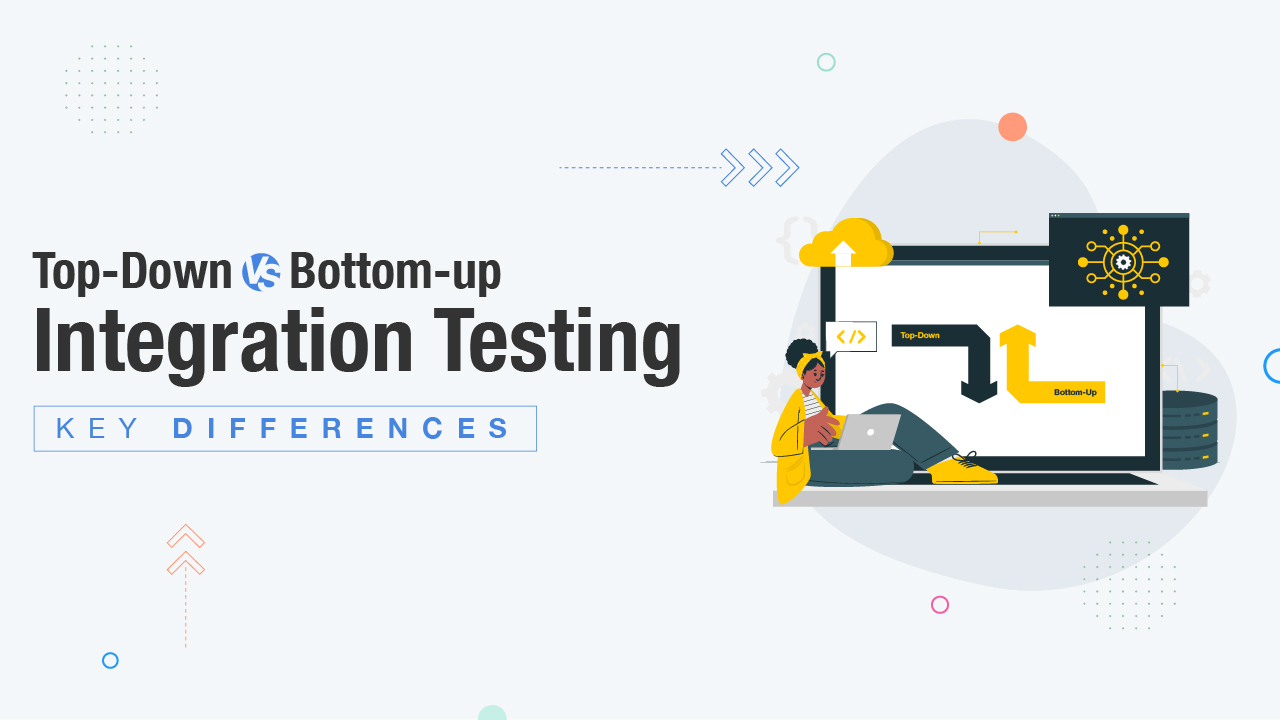Start automating your tests 10X Faster in Simple English with Testsigma
Try for freeOnce Unit testing is over and you integrate separate modules to form a complete system, Integration testing comes into the picture. It follows certain specifications to examine the interaction and behavior of different modules as they come together to build a system.
As such, Integration testing follows two approaches—Top-down and Bottom-up—that offer an organized way of building a programming structure, all the while continuing the testing processes. And this is the exact topic of this article. We will talk about the difference between Top-down and Bottom-up Integration testing for you to understand both approaches in detail.
However, you must have a thorough knowledge of Integration testing and its requirements before you jump to understanding its different approaches. So, here we begin.
Table Of Contents
What is Integration Testing?
Integration testing comes after Unit testing and follows the communication between several software modules after their design, development, and integration. Testers analyze connected components in this methodology to check for compatibility issues. Often, such issues arise between modules due to data transfer and software-hardware incompatibility.
There are several automation tools available to help you perform Integration testing. Some of the popular tools, such as Selenium, Pytest, Testsigma, and Protractor, are all open source and offer several in-house options and use cases for testing purposes.
Integration testing is conducted iteratively for the module group (making up the system) to find the errors. It is an agile methodology that follows the sprint cycle technique.
What are Different Types of Integration Testing?
As already mentioned, there are two approaches to Integration testing. But those are not the only two types. Integration testing has five types in total that testers can employ to perform as per their need:
Under this technique, either all or major modules are integrated for testing. It is only done after all the components are up and running.
Incremental testing is when a minimum of two (sometimes more) logically related modules are connected for testing, and the same process continues as more modules add to the system.
3. Top-Down Testing
Top-down testing follows a sequential path of dealing with the top modules before moving on to later or sub-modules.
The bottom-up approach is simply the opposite of Top-down testing.
5. Hybrid/Mixed
As the name suggests, hybrid or mixed Integration testing combines Top-down and Bottom-up to achieve the advantages of both types.
Although all these types have their use cases and advantages, this blog focuses on Top-down and Bottom-up approaches and the differences between them.
Point to Note: Top-down and Bottom-up come under the Incremental Integration testing approach.
What is Top-Down Integration Testing?
Top-down incremental Integration testing builds the program structure by moving from the top module to the lower modules. The process follows a certain downward hierarchy where the lower-level (sub-modules) modules are integrated into the top-level module (main module) using either a depth-first or breadth-first method. The primary advantage of this technique is to verify the control transfer and ease of integration as early as possible.
Almost all the Top-down models rely on Stubs (also called dummy programs) to run the testing. These stubs simulate the functioning of sub-modules.
What is Bottom-Up Integration Testing?
By the name of it, we are sure you know what Bottom-up Integration testing is and how it functions. But for more clarity, here’s the definition: Bottom-up Integration takes into account sub-modules and moves upward in the integration process. It eliminates the need for stubs, as lower-level modules are already available for integration before moving on to using the top module. It decreases the amount of overhead present in the Top-down approach.
However, there could be a few instances where all modules are still in production and require a dummy program. In such cases, drivers are used in Bottom-up Integration testing as opposed to stubs used in Top-down Integration testing. Drivers act as ‘calling programs’ as opposed to stubs that act as ‘called programs.
Difference Between Top Down and Bottom Up Integration Testing
Integration testing can be done in two ways: Top-down and Bottom-up. The fundamental difference between these two approaches is the direction of testing.
In Top-down testing, the testing process starts from the top module and moves downwards towards the sub-modules. The main focus is testing the top module before integrating it with the sub-modules.
In Bottom-up testing, the testing process is initiated by combining the sub-modules and then moving upwards to the top module.
The difference between Top-down and Bottom-up Integration testing is that the former moves downward, and the latter moves upward. Top-down focuses on designing and testing the top module before merging it with sub-modules. Bottom-up, on the other hand, combines the sub-modules to test them and moves upward thereafter.
| Characteristic | Top-Down Integration Testing | Bottom-Up Integration Testing |
| Approach | Tests the highest-level modules first and then works down the hierarchy. | Tests the lowest-level modules first and then works up the order. |
| Stubs | It uses stubs to simulate the lower-level modules. | It uses drivers to simulate the higher-level modules. |
| Complexity | Less complex. | More complex. |
| Data Intensity | Less data intensive. | More data intensive. |
| Risk coverage | Focuses on identifying and mitigating risks early on. | Focuses on identifying and mitigating risks later in the testing process. |
| Scope | It can be used to test large and complex systems. | It is better suited for testing smaller and less complex systems. |
| Suitability | It is suitable for systems that have a clear hierarchical structure. | It is suitable for systems that need a clear hierarchical structure. |
| Benefits | It can help to identify and mitigate risks early on. | It can help to ensure that the lower-level modules are working as expected. |
| Drawbacks | It can be challenging to implement for large and complex systems. | It can be time-consuming and data-intensive to execute. |
| Examples | Operating systems, database systems, and word-processing software. | Device drivers, embedded systems, and microcontrollers. |
| Other Differences | Main module calls the sub modules Uses stubs as a replacement for missing sub modules Implemented on structured/procedure-oriented programming Significant to identify errors at the top levels Difficult to observe the output Simple to perform | Sub modules integrated with the top module(s) Makes use of drivers as a replacement for main/top modules Beneficial for object-oriented programming Good to determine defects at lower levels Easy to observe and record the results Highly complex and data-driven |
Key Takeaways
At its foundation, Integration testing is the second level of testing right after Unit testing. All the system modules that are designed, developed, and tested during the Unit testing stage go through integration and further examination to check for compatibility issues. While Integration testing has multiple approaches that you can adopt as per your testing needs, two of the popular ones are Top-down and Bottom-up.
Both types have their advantages and disadvantages to help you decide which approach will best serve your needs. And if you are on the lookout for automation tools that guide your QA team to start and continue Integration testing based on any one of these two types, we recommend Testsigma and Selenium, as they both offer multiple options in terms of testing. You can choose the former if your team wishes to skip the coding part and move directly on to testing the application.
Frequently Asked Questions
What is the purpose of Bottom-up testing?
The purpose of Bottom-up Integration testing is to uncover crucial issues like input or output data usage, which are usually performed by sub-modules early in the testing stage. In short, it focuses on the analysis of specific characteristics and micro attributes of lower modules as per user requirements.
What is the purpose of Top-down testing?
The purpose of Top-down integration testing is to view all the components from the top and move downward in a manner to check the system’s functioning before starting to build the sub-modules. It will help you to catch errors even before you start working on every module of your application system.










